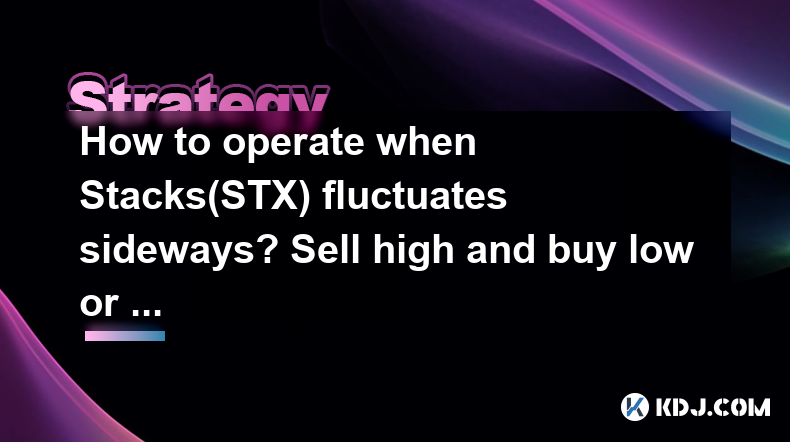-
 bitcoin
bitcoin $121833.232455 USD
-0.63% -
 ethereum
ethereum $4394.437030 USD
-2.00% -
 tether
tether $1.000570 USD
0.04% -
 bnb
bnb $1255.553465 USD
-3.73% -
 xrp
xrp $2.814944 USD
-1.59% -
 solana
solana $221.835346 USD
-2.40% -
 usd-coin
usd-coin $0.999869 USD
0.01% -
 dogecoin
dogecoin $0.249495 USD
-1.32% -
 tron
tron $0.336905 USD
-1.24% -
 cardano
cardano $0.816464 USD
-1.69% -
 chainlink
chainlink $22.130946 USD
-1.27% -
 hyperliquid
hyperliquid $44.208522 USD
-3.46% -
 ethena-usde
ethena-usde $1.000521 USD
0.02% -
 sui
sui $3.422897 USD
-2.51% -
 stellar
stellar $0.380164 USD
-1.31%
How to operate when Stacks(STX) fluctuates sideways? Sell high and buy low or wait and see?
When STX experiences sideways fluctuation, investors can either trade actively by selling high and buying low or adopt a passive approach, waiting for a breakout.
May 05, 2025 at 07:56 pm

When dealing with a cryptocurrency like Stacks (STX) that is experiencing sideways fluctuation, investors often find themselves at a crossroads: should they actively trade by selling high and buying low, or should they adopt a more passive approach and wait and see? This article delves into strategies for navigating such market conditions, offering detailed insights into both approaches.
Understanding Sideways Fluctuation in STX
Sideways fluctuation refers to a period when the price of Stacks (STX) moves within a relatively narrow range without a clear upward or downward trend. This can be a challenging time for investors because it can be difficult to predict the next significant move. Understanding the factors that contribute to this type of market movement is crucial for making informed decisions.
During periods of sideways fluctuation, market sentiment, trading volume, and external economic factors can all play a role. For instance, if there's a lack of significant news or developments within the Stacks ecosystem, the price may remain stable. Additionally, broader market trends in the cryptocurrency space can influence STX's behavior.
Strategy 1: Selling High and Buying Low
The strategy of selling high and buying low is a classic trading approach that aims to capitalize on small price movements within the sideways range. Here's how you can implement this strategy with STX:
- Identify the Range: Use technical analysis tools to identify the upper and lower bounds of the current sideways range. For example, if STX is trading between $0.50 and $0.60, these become your target levels.
- Set Buy and Sell Orders: Place a buy order near the lower end of the range (e.g., $0.51) and a sell order near the upper end (e.g., $0.59). This allows you to automatically enter and exit trades within the established range.
- Monitor and Adjust: Continuously monitor the market to adjust your orders based on any shifts in the range. If the range widens to $0.45 to $0.65, you would need to adjust your buy and sell orders accordingly.
- Manage Risk: Use stop-loss orders to limit potential losses. If your buy order at $0.51 is triggered, set a stop-loss order slightly below your entry point, such as $0.49, to protect against unexpected downward movements.
This approach requires active engagement and a keen eye on market movements, making it suitable for traders who are comfortable with frequent trading and have the time to monitor the market closely.
Strategy 2: Waiting and Seeing
Alternatively, adopting a wait-and-see approach involves holding onto your STX and waiting for a breakout from the sideways range. This strategy is more passive and can be beneficial for investors who believe in the long-term potential of Stacks.
- Hold Your Position: If you believe that STX is undervalued or has strong fundamentals, holding your position can be a wise choice. This allows you to avoid the transaction fees and potential losses associated with active trading.
- Monitor Key Indicators: Keep an eye on indicators such as trading volume, news related to Stacks, and overall market trends. A significant increase in volume or positive developments within the Stacks ecosystem could signal an impending breakout.
- Set Long-Term Goals: Define your investment goals and time horizon. If you're investing for the long term, waiting for a breakout can be a more suitable strategy than trying to profit from short-term fluctuations.
- Diversify Your Portfolio: While waiting, consider diversifying your cryptocurrency holdings to mitigate risk. This can help balance your exposure to STX and provide stability during periods of uncertainty.
This strategy is ideal for investors who prefer a more hands-off approach and are willing to wait for the right moment to act.
Technical Analysis Tools for STX
To effectively implement either strategy, using technical analysis tools can provide valuable insights into STX's price movements. Here are some key tools to consider:
- Moving Averages: Use moving averages to identify trends within the sideways range. For instance, a 50-day moving average can help you understand the short-term trend, while a 200-day moving average can provide insight into the long-term trend.
- Bollinger Bands: Bollinger Bands can help you visualize the volatility and range of STX's price. When the bands narrow, it indicates low volatility, which is often associated with sideways movement.
- Relative Strength Index (RSI): The RSI can help you identify overbought or oversold conditions within the range. An RSI above 70 may indicate that STX is overbought, while an RSI below 30 suggests it is oversold.
- Candlestick Patterns: Pay attention to candlestick patterns, such as doji or hammer patterns, which can signal potential reversals or continuations within the range.
Risk Management and Psychological Factors
Regardless of the strategy you choose, effective risk management is crucial. Here are some tips to manage your risks and navigate the psychological aspects of trading STX during sideways fluctuation:
- Set Clear Risk Parameters: Determine how much you're willing to risk on each trade and stick to those parameters. For example, if you're selling high and buying low, decide on a maximum percentage of your portfolio you're willing to allocate to each trade.
- Avoid Emotional Trading: Sideways markets can be frustrating, leading to emotional decisions. Stick to your strategy and avoid making impulsive trades based on short-term movements.
- Use Position Sizing: Adjust your position size based on your risk tolerance and the volatility of STX. Smaller positions can help you stay in the game longer without significant losses.
- Stay Informed: Keep up-to-date with news and developments related to Stacks and the broader cryptocurrency market. This can help you make more informed decisions and stay ahead of potential market shifts.
Choosing the Right Strategy for You
Deciding whether to sell high and buy low or wait and see depends on your investment goals, risk tolerance, and time commitment. If you're an active trader with the time and resources to monitor the market closely, selling high and buying low may be a suitable strategy. On the other hand, if you're a long-term investor who believes in the potential of Stacks, waiting for a breakout might be more appropriate.
Consider your personal circumstances and market conditions when making your decision. Both strategies have their merits, and the best approach may involve a combination of the two, adjusting your tactics based on the evolving market environment.
Frequently Asked Questions
Q1: How can I tell if STX is about to break out of a sideways range?A1: Look for signs such as increased trading volume, significant news or developments related to Stacks, and technical indicators like a breakout from Bollinger Bands or a strong move above or below key moving averages. These can signal that a breakout is imminent.
Q2: What are some common mistakes to avoid when trading STX during sideways fluctuation?A2: Common mistakes include overtrading, not setting stop-loss orders, ignoring transaction fees, and letting emotions drive trading decisions. It's important to stick to your strategy and manage your risks effectively.
Q3: Can I use both strategies simultaneously when dealing with STX?A3: Yes, you can use a hybrid approach by holding a portion of your STX for the long term while actively trading another portion within the sideways range. This allows you to benefit from potential short-term gains while maintaining exposure to long-term growth.
Q4: How does the overall cryptocurrency market affect STX during sideways fluctuation?A4: The broader cryptocurrency market can significantly impact STX's behavior. If the market as a whole is experiencing volatility or a downturn, STX may struggle to break out of its sideways range. Conversely, a bullish market can provide the momentum needed for a breakout.
Disclaimer:info@kdj.com
The information provided is not trading advice. kdj.com does not assume any responsibility for any investments made based on the information provided in this article. Cryptocurrencies are highly volatile and it is highly recommended that you invest with caution after thorough research!
If you believe that the content used on this website infringes your copyright, please contact us immediately (info@kdj.com) and we will delete it promptly.
- Chainlink, Reserve, LINK Price: Decoding the Signals
- 2025-10-10 10:45:14
- Meme Coins, ETFs, and Crypto Regulations: Navigating the Wild West of Digital Finance
- 2025-10-10 10:25:15
- HYPE, PENGU, and BlockDAG: Decoding Crypto's Latest Moves
- 2025-10-10 10:25:15
- Robinhood, Zora, and the Web3 Creator Revolution: A New York Minute on Tokenized Futures
- 2025-10-10 10:30:01
- Trump, Super Bowl, and Halftime: A Wild 2025 Ride
- 2025-10-10 10:30:01
- Cardano, XRP, and DeFi Integration: A Bombshell Development?
- 2025-10-10 08:25:17
Related knowledge

Practical parameter settings for a Bitcoin multi-timeframe moving average system
Sep 18,2025 at 10:54pm
Optimizing Timeframe Combinations for Bitcoin Trading1. Selecting appropriate timeframes is crucial when building a multi-timeframe moving average sys...

How can I filter out false breakouts in Dogecoin high-frequency trading?
Sep 22,2025 at 01:00am
Understanding False Breakouts in Dogecoin Trading1. A false breakout occurs when Dogecoin's price appears to move beyond a defined support or resistan...

Techniques for identifying tops and bottoms in the Bitcoin on-chain NVT model
Sep 20,2025 at 07:54pm
Understanding the NVT Model in Bitcoin Analysis1. The Network Value to Transactions (NVT) ratio is often described as the 'P/E ratio' of the cryptocur...

What does the surge in open interest in Bitcoincoin futures mean?
Sep 20,2025 at 11:18pm
Understanding the Surge in Dogecoin Futures Open Interest1. A surge in open interest within Dogecoin futures indicates a growing number of active cont...

How can I use the Ethereum USDT premium to gauge market sentiment?
Sep 18,2025 at 11:55pm
Understanding the Ethereum USDT Premium1. The Ethereum USDT premium refers to the price difference between USDT (Tether) traded on Ethereum-based plat...

What should I do if Ethereum staking yields decline?
Sep 20,2025 at 06:18am
Understanding the Causes Behind Declining Ethereum Staking Yields1. The Ethereum network transitioned to a proof-of-stake consensus mechanism with the...

Practical parameter settings for a Bitcoin multi-timeframe moving average system
Sep 18,2025 at 10:54pm
Optimizing Timeframe Combinations for Bitcoin Trading1. Selecting appropriate timeframes is crucial when building a multi-timeframe moving average sys...

How can I filter out false breakouts in Dogecoin high-frequency trading?
Sep 22,2025 at 01:00am
Understanding False Breakouts in Dogecoin Trading1. A false breakout occurs when Dogecoin's price appears to move beyond a defined support or resistan...

Techniques for identifying tops and bottoms in the Bitcoin on-chain NVT model
Sep 20,2025 at 07:54pm
Understanding the NVT Model in Bitcoin Analysis1. The Network Value to Transactions (NVT) ratio is often described as the 'P/E ratio' of the cryptocur...

What does the surge in open interest in Bitcoincoin futures mean?
Sep 20,2025 at 11:18pm
Understanding the Surge in Dogecoin Futures Open Interest1. A surge in open interest within Dogecoin futures indicates a growing number of active cont...

How can I use the Ethereum USDT premium to gauge market sentiment?
Sep 18,2025 at 11:55pm
Understanding the Ethereum USDT Premium1. The Ethereum USDT premium refers to the price difference between USDT (Tether) traded on Ethereum-based plat...

What should I do if Ethereum staking yields decline?
Sep 20,2025 at 06:18am
Understanding the Causes Behind Declining Ethereum Staking Yields1. The Ethereum network transitioned to a proof-of-stake consensus mechanism with the...
See all articles

























![Web3 Crypto Market Morning Report: Fomo on the Bnb chain continues, Binance launches the chain-sweeping platform Meme Rush, the market value of Xiuxian exceeds 40 million U.S. dollars, OK Binance business war begins [Vic TALK Issue 1437] Web3 Crypto Market Morning Report: Fomo on the Bnb chain continues, Binance launches the chain-sweeping platform Meme Rush, the market value of Xiuxian exceeds 40 million U.S. dollars, OK Binance business war begins [Vic TALK Issue 1437]](/uploads/2025/10/10/cryptocurrencies-news/videos/web-crypto-market-morning-report-fomo-bnb-chain-continues-binance-launches-chainsweeping-platform-meme-rush-market-xiuxian-exceeds-dollars-binance-business-war-vic-talk-issue/68e861c5dbd1c_image_500_375.webp)
















































